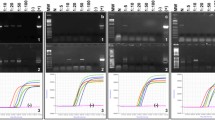Abstract
Detection of pathogen DNA by polymerase chain reaction (PCR) assays is the most widely used method for diagnosing phytoplasma diseases. Reliable and efficient detection of phytoplasmas, especially in woody perennial plants, is challenging due to the unusually low abundance and sporadic distribution of phytoplasmas within infected host tissues. Detection success depends largely upon the host species and sampling procedures and, to a lesser extent, on the protocol used for DNA extraction. Here we describe a simple, straightforward, nondestructive stem sampling protocol to confirm phytoplasma infection of palms and other arborescent monocots of large stature. The protocol requires minimal processing of excised tissues and yields phytoplasma DNA preparations in suitable quantity for reliable detection by nested PCR assays.
Access this chapter
Tax calculation will be finalised at checkout
Purchases are for personal use only
Similar content being viewed by others
References
Boudon-Padieu E et al (2003) Grapevine yellows: comparison of different procedures for DNA extraction and amplification with PCR for routine diagnosis of phytoplasmas in grapevine. Vitis 42:141–149
Christensen NM et al (2004) Distribution of phytoplasmas in infected plants as revealed by real-time PCR and bioimaging. Mol Plant Microbe Interact 17:1175–1184
Oropeza C et al (2011) Phytoplasma distribution in coconut palms affected by lethal yellowing disease. Ann Appl Biol 159:109–117
Thomas DL, Norris RC (1980) The use of the electron microscope for lethal yellowing diagnosis. Proc Fla State Hortic Soc 93:196–199
Baric S et al (2011) Seasonal colonisation of apple trees by ‘Candidatus Phytoplasma mali’ revealed by a new quantitative TaqMan real-time PCR approach. Eur J Plant Pathol 129:455–467
Berges R, Rott M, Seemüller E (2000) Range of phytoplasma concentrations in various plant hosts as determined by competitive polymerase chain reaction. Phytopathology 90:1145–1152
Jarausch W, Lansac M, Dosba F (1999) Seasonal colonization pattern of European stone fruit yellows phytoplasma in different Prunus species detected by specific PCR. J Phytopathol 147:47–54
Marzachì C (2006) Molecular diagnosis of phytoplasmas. Arab J Plant Prot 24:139–142
Gibb K, Padovan A (1994) A DNA extraction method that allows reliable PCR amplification of MLO DNA from “difficult” plant host species. Genome Res 4:56–58
Green MJ, Thompson DA, MacKenzie DJ (1999) Easy and efficient DNA extraction from woody plants for the detection of phytoplasmas by polymerase chain reaction. Plant Dis 83:482–485
Heinrich M et al (2001) Improved detection methods for fruit tree phytoplasmas. Plant Mol Biol Rep 19:169–179
Lee I-M, Davis RE (1983) Phloem-limited prokaryotes in sieve elements isolated by enzyme treatment of diseased plant tissues. Phytopathology 73:1540–1543
Palmano S (2001) A comparison of different phytoplasma DNA extraction methods using competitive PCR. Phytopathol Mediterr 40:99–107
Cordova I et al (2000) First report of a phytoplasma-associated leaf yellowing syndrome of Palma Jipi plants in southern Mexico. Plant Dis 84:807
Thomas DL, Donselman HM (1979) Mycoplasmalike bodies and phloem degeneration associated with declining Pandanus in Florida. Plant Dis Rep 63:911–916
Vázquez-Euán R et al (2011) Occurrence of a 16SrIV group phytoplasma not previously associated with palm species in Yucutan, Mexico. Plant Dis 95:256–262
Kirkpatrick BC et al (1995) Isolation of mycoplasma-like organism DNA from plant and insect hosts. In: Razin S, Tully JG (eds) Molecular and diagnostic procedures in mycoplasmology Vol. 1, molecular characterization. Academic, New York, pp 105–117
Prince JP et al (1993) Molecular detection of diverse mycoplasmalike organisms (MLOs) associated with grapevine yellows and their classification with aster yellows, X-disease, and elm yellows MLOs. Phytopathology 83:1130–1137
Ahrens U, Seemüller E (1992) Detection of DNA of plant pathogenic mycoplasmalike organisms by a polymerase chain reaction that amplifies a sequence of the 16S rRNA gene. Phytopathology 82:828–832
Doyle JJ, Doyle JL (1990) Isolation of plant DNA from fresh tissue. Focus 12:13–15
Kollar A et al (1990) Isolation of the DNA of various plant pathogenic mycoplasmalike organisms from infected plants. Phytopathology 80:233–237
Zhang Y-P, Uyemoto JK, Kirkpatrick BC (1998) A small-scale procedure for extracting nucleic acids from woody plants infected with various phytopathogens for PCR assay. J Virol Methods 71:45–50
Jiang YP, Chen TA (1987) Purification of mycoplasma-like organisms from lettuce with aster yellows disease. Phytopathology 77:949–953
Harrison NA et al (2001) Detection and characterization of an elm yellows (16SrV) group phytoplasma infecting Virginia creeper plants in southern Florida. Plant Dis 85:1055–1062
Harrison NA, Helmick EE, Elliott ML (2008) Lethal yellowing-type diseases of palms associated with phytoplasmas newly identified in Florida, USA. Ann Appl Biol 153:85–94
Harrison NA, Womack M, Carpio ML (2002) Detection and characterization of a lethal yellowing (16SrIV) group phytoplasma in Canary Island date palms affected by lethal decline in Texas. Plant Dis 86:676–681
Nejat N et al (2009) Phytoplasmas associated with disease of coconut in Malaysia: phylogenetic groups and host plant species. Plant Pathol 58:1152–1160
Author information
Authors and Affiliations
Corresponding author
Editor information
Editors and Affiliations
Rights and permissions
Copyright information
© 2013 Springer Science+Business Media, LLC
About this protocol
Cite this protocol
Harrison, N.A., Davis, R.E., Helmick, E.E. (2013). DNA Extraction from Arborescent Monocots and How to Deal with Other Challenging Hosts. In: Dickinson, M., Hodgetts, J. (eds) Phytoplasma. Methods in Molecular Biology, vol 938. Humana Press, Totowa, NJ. https://doi.org/10.1007/978-1-62703-089-2_13
Download citation
DOI: https://doi.org/10.1007/978-1-62703-089-2_13
Published:
Publisher Name: Humana Press, Totowa, NJ
Print ISBN: 978-1-62703-088-5
Online ISBN: 978-1-62703-089-2
eBook Packages: Springer Protocols




